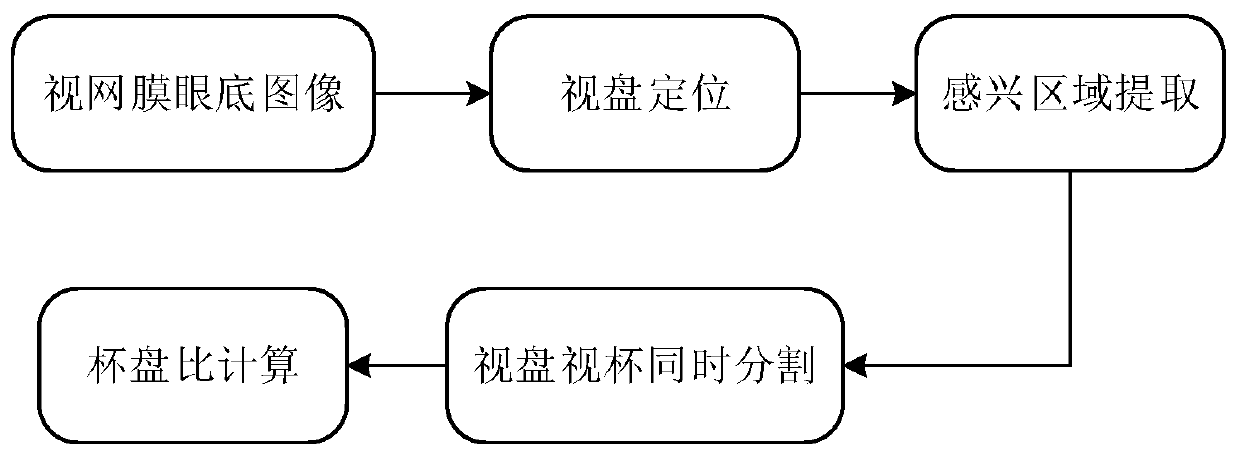A retinal fundus image cup/disc ratio automatic evaluation method
A fundus image, automatic evaluation technology, applied in image enhancement, image analysis, image data processing and other directions, can solve the problem of manual extraction, inability to accurately segment the optic disc and optic cup at the same time, and achieve the effect of enhancing accuracy and robustness
- Summary
- Abstract
- Description
- Claims
- Application Information
AI Technical Summary
Problems solved by technology
Method used
Image
Examples
Embodiment 1
[0083] This embodiment is aimed at retinal fundus images, and the automatic evaluation of the cup-to-disk ratio is carried out in the following steps. The overall implementation process is as follows: figure 1 As shown, the detailed implementation process is as follows figure 2 Shown:
[0084] Step A: use image processing and sliding window methods to locate the optic disc area of the retinal fundus image, and extract the located optic disc area as an area of interest (ie ROI area) from the retinal fundus image to obtain the optic disc area image of the retinal fundus image, The process of locating the optic disc area is as follows image 3 shown.
[0085] Step A1. Morphologically process the original color retinal fundus image to obtain a grayscale enhanced retinal fundus image F':
[0086] Since different fundus imaging equipment under different environmental conditions will result in low fundus contrast or overall dark fundus, morphological processing can be used to...
Embodiment 2
[0153] For the original color retinal fundus image [such as Figure 7 (a)] (with a size of 2048×3047) to extract the cup-to-disk ratio. The first step is the positioning of the optic disc. First, the original color retinal fundus image is replaced with a grayscale image, and the bottom hat transformation is performed on the grayscale image to obtain the bottom hat transformed image [eg Figure 7 As shown in (b)], the same top-hat transformation is performed on the gray-scale fundus image to obtain the top-hat transformation image [such as Figure 7 (c)]. Then combine the obtained top-hat transformed image, bottom-hat transformed image and the original gray-scale fundus image to calculate the gray-scale retinal fundus enhanced image according to formula (1) [eg Figure 7 (d)]. Then extract the brightest area of the grayscale retinal fundus enhanced image by extracting the histogram of the enhanced retinal fundus image, using iterative accumulation to select the brightest ...
Embodiment 3
[0158] Raw color retinal fundus images [eg Figure 9 (a)] (with a size of 2048×3047) to extract the cup-to-disk ratio. The first step is to position the optic disc. First, the original color retinal fundus image is replaced with a grayscale image, and the bottom hat transformation is performed on the grayscale image to obtain the bottom hat transformed image [eg Figure 9 Shown in (b)], the same top-hat transformation is performed on the gray-scale fundus image to obtain the top-hat transformation image [such as Figure 9 (c)]. Then combine the obtained top-hat transformed image, bottom-hat transformed image and the original gray-scale fundus image to calculate the gray-scale retinal fundus enhanced image according to formula (1) [eg Figure 9 (d)]. Then extract the brightest area of the grayscale retinal fundus enhanced image by extracting the histogram of the enhanced retinal fundus image, using iterative accumulation to select the brightest pixel that accounts for 6.5...
PUM
 Login to View More
Login to View More Abstract
Description
Claims
Application Information
 Login to View More
Login to View More - R&D
- Intellectual Property
- Life Sciences
- Materials
- Tech Scout
- Unparalleled Data Quality
- Higher Quality Content
- 60% Fewer Hallucinations
Browse by: Latest US Patents, China's latest patents, Technical Efficacy Thesaurus, Application Domain, Technology Topic, Popular Technical Reports.
© 2025 PatSnap. All rights reserved.Legal|Privacy policy|Modern Slavery Act Transparency Statement|Sitemap|About US| Contact US: help@patsnap.com



